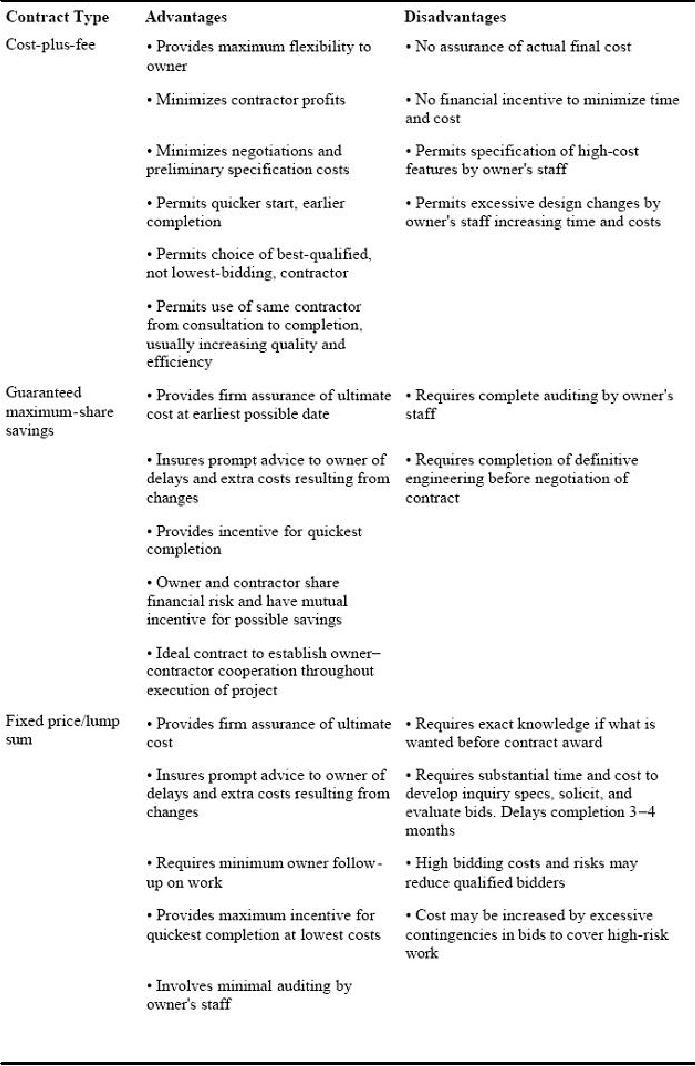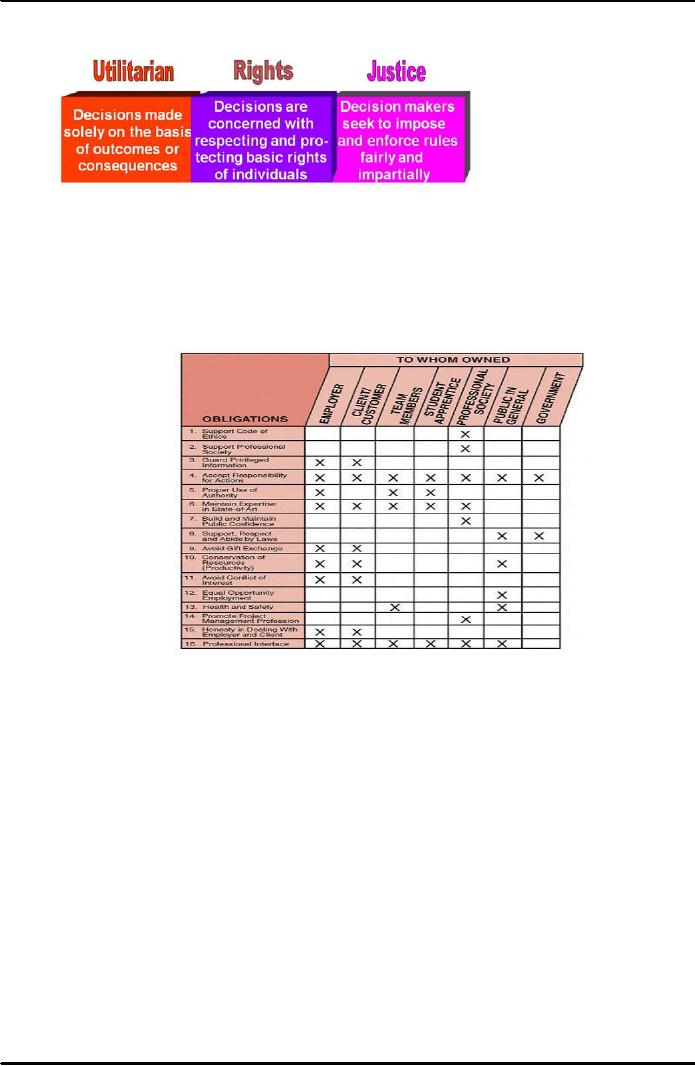 |
PROJECT PROCUREMENT, CONTRACT MANAGEMENT, AND ETHICS IN PROJECT MANAGEMENT:Procurement Cycles |
| << PROJECT RISK MANAGEMENT:Components of Risk, Categories of Risk, Risk Planning |

Project
Management MGMT627
VU
LESSON
45
PROJECT
PROCUREMENT, CONTRACT MANAGEMENT, AND
ETHICS IN
PROJECT
MANAGEMENT
BROAD
CONTENTS
Procurement
Procurement
Cycles
Type
of contract
Categories
of Contract
Ethics
in Project Management
45.1.
Procurement
Procurement
can be defined as the acquisition of
goods or services. Procurement (and
contracting) is a
process
that involves two parties
with different objectives
who interact in a given
market segment. Good
procurement
practices can increase corporate
profitability by taking advantage of
quantity discounts,
minimizing
cash flow problems, and seeking out
quality suppliers. Because procurement
contributes to
profitability,
procurement is often centralized, which
results in standardized practices and
lower
paperwork
costs.
All
procurement strategies are frameworks by
which an organization attains its
objectives. There are
two
basic procurement strategies:
Corporate
procurement strategy: the relationship of
specific procurement actions to the corporate
strategy
Project
procurement strategy: the relationship of
specific procurement actions to the
operating
environment
of the project
Project
procurement strategies can differ
from corporate procurement strategies
because of constraints,
availability
of critical resources, and
specific customer requirements. Corporate
strategies might
promote
purchasing small quantities from several
qualified vendors, whereas project
strategies may
dictate
sole source procurement.
Procurement
planning usually involves the selection
of one of the following as the primary
objective:
�
Procure
all goods/services from a
single source.
�
Procure
all goods/services from
multiple sources.
�
Procure
only a small portion of the
goods/services.
�
Procure
none.
Another
critical factor is the environment in
which procurement must take place.
There are two
environments:
macro and micro. The macro
environment includes the general external
variables that
can
influence how and when we do procurement.
These include recessions,
inflation, cost of
borrowing
money, and unemployment. As an example, a
foreign corporation had undertaken a
large
project
that involved the hiring of several
contractors. Because of the country's high
unemployment
rate,
the decision was made to use
only domestic suppliers/contractors and to give
first preference to
contractors
in cities where unemployment was the
greatest, even though there were other
more
qualified
suppliers/contractors.
362

Project
Management MGMT627
VU
The
microenvironment is the internal
environment of the firm, especially the
policies and
procedures
imposed by the firm, project, or client
in the way that procurement will
take place.
This
includes the procurement/contracting
system, which contains five
cycles:
Requirement
cycle: definition of the boundaries of the
project
Requisition
cycle: analysis of sources
Solicitation
cycle: the bidding
process
Award
cycle: contractor selection and contract
award
Contract
administration cycle: managing the
subcontractor until completion of the
contract
There
are several activities that
are part of the procurement process and
that overlap several of the
cycles.
These cycles can be conducted in
parallel, especially requisition and
solicitation.
45.2.
Procurement
Cycles
The
first step in the procurement process is
the definition of project, specifically
the requirement.
This
is referred to as the requirement cycle
and includes the following:
Defining
the need for the
project
Development
of the statement of work, specifications,
and work breakdown structure
Performing
a make or buy analysis
Laying
out the major milestones and the
timing/schedule
Cost
estimating, including life-cycle
costing
Obtaining
authorization and approval to
proceed
The
SOW is a narrative description of the
work to be accomplished and/or the
resources to be
supplied.
The identification of resources to be
supplied has taken on paramount
importance during
the
last ten years or so. During the
1970s and 1980s, small
companies were bidding on mega
jobs
only
to subcontract out more than 99% of
all of the work. Lawsuits were abundant
and the solution
was
to put clauses in the SOW
requiring that the contractor identify
the names and resumes of
the
talented
internal resources that
would be committed to the project,
including the percentage of
their
time
on the project. Specifications are
written, pictorial, or graphic
information that describe,
define,
or
specify the services or items to be procured.
There are three types of
specifications:
Design
specifications: These detail
what is to be done in terms of physical
characteristics. The
risk
of
performance is on the buyer.
Performance
specifications: These specify
measurable capabilities the end product
must achieve in
terms
of operational characteristics. The risk
of performance is on the contractor.
Functional
specifications: This is when the
seller describes the end use of the
item to stimulate
competition
among commercial items, at a lower
overall cost. This is a
subset of the performance
specification,
and the risk of performance is on the
contractor.
There
are always options in the
way the end item can be
obtained. Feasible procurement
alternatives
include
make or buy, lease or buy,
buy or rent, and lease or
rent. Buying domestic or international
is
also
of critical importance, especially to the
United Auto Workers Union.
Factors involving the
make
or buy analysis is shown below:
�
The
make decision
�
Less
costly (but not
always!!)
�
Easy
integration of operations
�
Utilize
existing capacity that is
idle
�
Maintain
direct control
�
Maintain
design/production secrecy
�
Avoid
unreliable supplier
base
�
Stabilize
existing workforce
�
The
buy decision
363

Project
Management MGMT627
VU
�
Less
costly (but not
always!!)
�
Utilize
skills of suppliers
�
Small
volume requirement (not cost
effective to produce)
�
Having
limited capacity or
capability
�
Augment
existing labor force
�
Maintain
multiple sources (qualified
vendor list)
�
Indirect
control
The
lease or rent decision is
usually a financial endeavor.
Leases are usually longer
term than
renting.
Consider the following example. A company is
willing to rent you a piece of
equipment at a
cost
of $100 per day. You can
lease the equipment for $60
per day plus a one-time cost
of $5000.
What
is the breakeven point, in days, where
leasing and renting are the
same?
Therefore,
if the firm wishes to use
this equipment for more than
125 days, it would be more
cost
effective
to sign a lease agreement rather
than a rental
agreement.
Requisition
Cycle
Once
the requirements are identified, a
requisition form is sent to procurement
to begin the
requisition
process. The requisition
cycle includes:
Evaluating/confirming
specifications (are they
current?)
Confirming
sources
Reviewing
past performance of sources
Producing
solicitation package
The
solicitation package is prepared during
the requisition cycle but
utilized during the
solicitation
cycle.
In most situations, the same
solicitation package must be
sent to each possible supplier so
that
the
playing field is level. A
typical solicitation package
would include:
Bid
documents (usually standardized)
Listing
of qualified vendors (expected to
bid)
Proposal
evaluation criteria
Bidder
conferences
How
change requests will be
managed
Supplier
payment plan
Standardized
bid documents usually
include standard forms for
compliance with EEO,
affirmative
action,
OSHA/EPA, minority hiring,
etc. A listing of qualified vendors
appears in order to
drive
down
the cost. Quite often, one
vendor will not bid on the
job because it knows that it
cannot submit
a
lower bid than one of the
other vendors. The cost of
bidding on a job is an expensive
process.
Bidder
conferences are used so that
no single bidder has more
knowledge than others. If a
potential
bidder
has a question concerning the
solicitation package, then it
must wait for the
bidders'
conference
to ask the question so that
all bidders will be privileged to the
same information. This
is
particularly
important in government contracting.
There may be several bidders'
conferences
between
solicitation and award. Project
management may or may not be
involved in the bidders'
conferences,
either from the customer's
side or the contractor's side.
Solicitation
Cycle
Selection
of the acquisition method is the critical element in
the solicitation cycle. There
are three
common
methods for
acquisition:
364

Project
Management MGMT627
VU
�
Advertising
�
Negotiation
�
Small
purchases (i.e., office
supplies)
Advertising
is when a company goes out
for sealed bids. There
are no negotiations.
Competitive
market
forces determine the price
and the award goes to the lowest
bidder.
Negotiation
is when the price is determined
through a bargaining process. In
such a situation, the
customer
may go out for a:
�
Request
for information (RFI)
�
Request
for quotation (RFQ)
�
Request
for proposal (RFP)
The
RFP is the most costly endeavor
for the vendor. Large proposals
contain separate volumes
for
cost,
technical performance, management
history, quality, facilities,
subcontractor management, and
others.
The negotiation process can
be competitive or noncompetitive.
Noncompetitive processes
are
called sole-source procurement.
On
large contracts, the negotiation
process goes well beyond
negotiation of the bottom
line.
Separate
negotiations can be made on
price, quantity, quality, and
timing. Vendor relations
are
critical
during contract negotiations. The
integrity of the relationship and
previous history can
shorten
the negotiation process. The three
major factors of negotiations are:
�
Compromise
ability
�
Adaptability
�
Good
faith
Negotiations
should be planned for. A
typical list of activities
would include:
�
Develop
objectives (i.e., min-max
positions)
�
Evaluate
your opponent
�
Define
your strategy and
tactics
�
Gather
the facts
�
Perform
a complete price/cost analysis
�
Arrange
''hygiene" factors
If
you are the buyer, what is
the maximum you will be
willing to pay? If you are the
seller, what is
the
minimum you are willing to
accept? You must determine
what motivates your
opponent. Is your
opponent
interested in profitability, keeping
people employed, developing a
new technology, or
using
your name as a reference?
This knowledge could
certainly affect your strategy
and tactics.
Hygiene
factors include where the negotiations
will take place. In a restaurant?
Hotel? Office?
Square
table or round tables?
Morning or afternoon? Who
faces the windows and who
faces the
walls?
There should be a postnegotiation
critique in order to review
what was learned. The
first type
of
postnegotiation critique is internal to
your firm. The second
type of postnegotiation critique
is
with
all of the losing bidders to explain
why they did not
win the contract. Losing bidders
may
submit
a "bid protest" where the customer
may have to prepare a detailed report as
to why this
bidder
did not win the contract.
Bid protests are most common
on government contracts.
Award
Cycle
The
award cycle results in a signed contract.
Unfortunately, there are several types of
contracts. The
negotiation
process also includes the selection of
the type of contract.
There
are certain basic elements
of most contracts.
Mutual
agreement: There must be an offer
and acceptance.
Consideration:
There must be a down
payment.
Contract
capability: The contract is binding
only if the contractor has the capability
to perform the
work.
365

Project
Management MGMT627
VU
The
objective of the award cycle is to
negotiate a contract type and price
that will result in
reasonable
contractor risk and provide the contractor
with the greatest incentive
for efficient and
economic
performance.
Legal
purpose: The contract must be for a
legal purpose.
Form
provided by law: The contract
must reflect the contractor's legal
obligation, or lack of
obligation,
to deliver end products.
The
two most common contract forms
are completion contracts and
term contracts.
Completion
contract: The contractor is required to
deliver a definitive end product.
Upon delivery
and
formal acceptance by the customer, the contract is
considered complete, and final payment
can
be
made.
Term
contract: The contract is required to
deliver a specific "level of
effort," not an end
product.
The
effort is expressed in woman/man-days (months or
years) over a specific
period of time using
specified
personnel skill levels and facilities.
When the contracted effort is performed,
the
contractor
is under no further obligation.
Final payment is made,
irrespective of what is
actually
accomplished
technically.
The
final contract is usually referred to as
a definitive contract, which follows
normal contracting
procedures
such as the negotiation of all
contractual terms, conditions,
cost, and schedule prior
to
initiation
of performance. Unfortunately, negotiating the
contract and preparing it for
signatures
may
require months of preparation. If the
customer needs the work to
begin immediately or if
long-
lead
procurement is necessary, then the
customer may provide the
contractor with a letter
contract
or
letter of intent. The letter
contract is a preliminary written
instrument authorizing the
contractor
to
begin immediately the manufacture of supplies or the
performance of services. The final
contract
price
may be negotiated after performance
begins, but the contractor may
not exceed the "not
to
exceed"
face value of the contract. The
definitive contract must still be
negotiated.
�
The
type of contract selected is based
upon the following:
�
Overall
degree of cost and schedule
risk
�
Type
and complexity of requirement (technical
risk)
�
Extent
of price competition
�
Cost/price
analysis
�
Urgency
of the requirements
�
Performance
period
�
Contractor's
responsibility (and
risk)
�
Contractor's
accounting system (is it capable of
earned value
reporting?)
�
Concurrent
contracts (will my contract take a back
seat to existing
work?)
�
Extent
of subcontracting (how much work
will the contractor outsource?)
45.3.
Types of
Contracts
Before
analyzing the various types of contracts,
one should be familiar with the
terminology found
in
them.
The
target cost or estimated cost is the
level of cost that the
contractor will most likely
obtain under
normal
performance conditions. The target
cost serves as a basis for
measuring the true cost at the
end
of production or development. The
target cost may vary
for different types of contracts
even
though
the contract objectives are the same.
The target cost is the most
important variable
affecting
research
and development.
Target
or expected profit is the profit value
that is negotiated for, and
set forth, in the contract.
The
expected
profit is usually the largest portion of
the total profit.
Profit
ceiling and profit floor are
the maximum and minimum values,
respectively, of the total
profit.
These quantities are often
included in contract negotiations.
366

Project
Management MGMT627
VU
Price
ceiling or ceiling price is the amount of
money for which the
government is responsible. It is
usually
measured as a given percentage of the
target cost, and is
generally greater than the
target
cost.
Maximum
and minimum fees are
percentages of the target cost and
establish the outside limits of
the
contractor's profit.
The
sharing arrangement or formula gives the
cost responsibility of the customer to
the cost
responsibility
of the contractor for each dollar
spent. Whether that dollar
is an overrun or an under-
run
dollar, the sharing arrangement has the
same impact on the contractor.
This sharing arrangement
may
vary depending on whether the
contractor is operating above or below
target costs.
The
production point is usually
that level of production above
which the sharing arrangement
commences.
Point
of total assumption is the point (cost or
price) where the contractor assumes all
liability for
additional
costs.
At
one end of the range is the cost-plus, a fixed-fee
type of contract where the company's
profit,
rather
than price, is fixed and the
company's responsibility, except for
its own negligence,
is
minimal.
At the other end of the range is the lump
sum or turnkey type of contract
under which the
company
has assumed full
responsibility, in the form of profit or
losses, for timely performance
and
for
all costs under or over the
fixed contract price. In between are
various types of contracts, such
as
the
guaranteed maximum, incentive types of
contracts, and the bonus-penalty type of
contract.
These
contracts provide for
varying degrees of cost
responsibility and profit depending on
the level
of
performance. Contracts that cover the
furnishing of consulting services
are generally on a per
diem
basis at one end of the range and on a fixed-price
basis at the other end of the
range.
Because
no single form of contract agreement
fits every situation or
project, companies
normally
perform
work in the United States
under a wide variety of
contractual arrangements, such
as:
�
Cost-plus
percentage fee
�
Cost-plus
fixed fee
�
Cost-plus
guaranteed maximum
�
Cost-plus
guaranteed maximum and shared
savings
�
Cost-plus
incentive (award fee)
�
Cost
and cost sharing
�
Fixed
price or lump sum
�
Fixed
price with
re-determination
�
Fixed
price incentive fee
�
Fixed
price with economic price
adjustment
�
Fixed
price incentive with
successive targets
�
Fixed
price for services,
material, and labor at cost
(purchase orders, blanket
agreements)
�
Time
and material/labor hours only
�
Bonus-penalty
�
Combinations
�
Joint
venture
At
one end of the range is the cost-plus, a fixed-fee
type of contract where the company's
profit,
rather
than price, is fixed and the
company's responsibility, except for
its own negligence,
is
minimal.
At the other end of the range is the lump
sum or turnkey type of contract
under which the
company
has assumed full
responsibility, in the form of profit or
losses, for timely performance
and
for
all costs under or over the
fixed contract price. In between are
various types of contracts, such
as
the
guaranteed maximum, incentive types of
contracts, and the bonus-penalty type of
contract.
367

Project
Management MGMT627
VU
These
contracts provide for
varying degrees of cost
responsibility and profit depending on
the level
of
performance. Contracts that cover the
furnishing of consulting services
are generally on a per
diem
basis at one end of the range and on a fixed-price
basis at the other end of the
range.
There
are generally five types of
contracts to consider:
�
Fixed-Price
(FP),
�
Cost
-Plus-Fixed-Fee (CPFF), Or
Cost-Plus-Percentage-Fee (CPPF),
�
Guaranteed
Maximum-Shared Savings (GMSS),
�
Fixed-Price-Incentive-Fee
(FPIF), And
�
Cost-Plus-Incentive-Fee
(CPIF) Contracts.
Each
type is discussed
separately.
Fixed-Price
(FP)
Under
a fixed-price or lump-sum contract, the contractor
must carefully estimate the
target cost.
The
contractor is required to perform the
work at the negotiated contract value. If
the estimated
target
cost was low, the total
profit is reduced and may
even vanish. The contractor may
not be able
to
underbid the competitors if the expected cost is
overestimated. Thus, the contractor assumes a
large
risk.
This
contract provides maximum protection to
the owner for the ultimate
cost of the project, but
has
the
disadvantage of requiring a long period
for preparation and adjudications of
bids. Also, there is
the
possibility that because of a
lack of knowledge of local
conditions, all contractors
may
necessarily
include an excessive amount of
contingency. This form of contract
should never be
considered
by the owner unless, at the time
bid invitations are issued,
the building requirements are
known
exactly. Changes requested by the
owner after award of a contract on a lump
sum basis lead
to
troublesome and sometimes costly
extras.
Cost
-Plus-Fixed-Fee (CPFF), Or Cost-Plus-Percentage-Fee
(CPPF)
Traditionally,
the cost-plus-fixed-fee contract has been
employed when it was
believed that
accurate
pricing
could not be achieved any
other way. In the CPFF contract, the
cost may vary but the
fee
remains
firm. Because, in a cost-plus contract, the contractor
agrees only to use his
best efforts to
perform
the work, good performance and poor
performance are, in effect, rewarded
equally. The
total
dollar profit tends to produce
low rates of return,
reflecting the small amount of risk
that the
contractor
assumes. The fixed fee is
usually a small percentage of the
total or true cost.
The
cost-plus contract requires that the company books be
audited. With this form of
contract the
engineering-construction
contractor bids a fixed dollar fee or
profit for the services to be
supplied
by
the contractor, with engineering,
materials, and field labor
costs to be reimbursed at actual
cost.
This
form of bid can be prepared
quickly at a minimal expense to
contractor and is a simple bid
for
the
owner to evaluate. Additionally, it
has the advantage of establishing
incentive to the contractor
for
quick completion of the
job.
If
it is a cost-plus-percentage -fee contract, it
provides maximum flexibility to the
owner and
permits
owner and contractor to work
together cooperatively on all
technical, commercial, and
financial
problems. However, it does not
provide financial assurance of
ultimate cost. Higher
building
cost may result, although
not necessarily so, because of
lack of financial incentive to
the
contractor
compared with other forms.
The only meaningful
incentive that is evident
today is the
increased
competition and prospects
for follow-on
contracts.
368

Project
Management MGMT627
VU
Guaranteed
Maximum-Shared Savings
(GMSS)
Under
the guaranteed maximum-share savings contract, the contractor is
paid a fixed fee for
his
profit
and reimbursed for the actual cost of
engineering, materials, construction
labor, and all other
job
costs, but only up to the
ceiling figure established as the
"guaranteed maximum." Savings
below
the
guaranteed maximum are shared between
owner and contractor,
whereas contractor assumes the
responsibility
for any overrun beyond the
guaranteed maximum price.
This
contract form essentially combines the
advantages as well as a few of
the disadvantages of
both
lump sum and cost-plus contracts.
This is the best form for a
negotiated contract because it
establishes
a maximum price at the earliest possible
date and protects the owner against
being
overcharged,
even though the contract is awarded without
competitive tenders. The
guaranteed
maximum-share
savings contract is unique in that the
owner and contractor share the
financial risk
and
both have a real incentive to complete
the project at lowest possible
cost.
Fixed-Price-Incentive-Fee
(FPIF)
Fixed-price-incentive-fee
contracts are the same as
fixed-price contracts except that
they have a
provision
for adjustment of the total profit by a
formula that depends on the
final total cost at
completion
of the project and that has
been agreed to in advance by
both the owner and the
contractor.
To use this type of contract, the
project or contract requirements must be
firmly
established.
This contract provides an incentive to
the contractor to reduce costs and
therefore
increase
profit. Both the owner and contractor
share in the risk and
savings.
Cost-Plus-Incentive-Fee
(CPIF) Contracts
Cost-plus-incentive-fee
contracts are the same as
cost plus contracts except
that they have a
provision
for adjustment of the fee as determined by a
formula that compares the
total project costs
to
the target cost. This
formula is agreed to in advance by
both the owner and contractor.
This
contract
is usually used for
long-duration or R&D type projects.
The company places more risk
on
the
contractor and forces him to
plan ahead carefully and
strive to keep costs
down.
369

Project
Management MGMT627
VU
370

Project
Management MGMT627
VU
45.4.
ETHICS
Ethical
Origins
Societal
Ethics: Standards of Members of
Society use when dealing
with each other Based
on
"Values
& standards"
Societal
Ethics: Found in Society's
Legal Rules, Norm, & Mores.
Codified in the "Form of Law"
&
Society
Customer.
Norms
dictate how people should
behave. Societal ethics vary
based on a given Society.
Strong
beliefs
in one country differ
elsewhere.
Professional
Ethics: Professional Ethics are the
Values & standards used by
Group of Managers in
workplace.
They are applied when
decision not "Clear-Cut
Ethically". Some examples
are the
practices
of Physicians/Lawyers Professional Associates
(PMA, Bar Council)
Values:
are an individual's basic
convictions of what is "Right &
Wrong". They are the basic
beliefs
about
what one should or should
not do? & what is & is
not important?
Individual
Ethics: are the values of an individual
resulting from their family
& upbringing.
Ethics
codes & policies provide
sign of top management's desires in
project based
organizational
culture.
Project manager should behave
ethically to avoid harming others.
Managers responsible for
"protecting
& nurturing resources" in their
charge. Leadership, Culture and
Incentive Compensation
Plans
help Shape "Individual
Ethical behavior" in project
management promoting ethics. There
is
strong
evidence showing that ethical
managers benefit in the longer
run. Firms increasingly seek
to
make
good ethics part of norm
& organizational culture. Ethical
decisions involve normative
judgment
implies "something is good or bad,
right or wrong, better or
worse." Some examples
are:
Should
you pay compensation pay to
lay off workers?
Should
you buy goods from
overseas firms that hire
children? (If you don't
Children may not
earn
enough
money to eat)
371

Project
Management MGMT627
VU
Views
of Ethical Decision-Making
Figure
45.1: Views of Ethical
Decision Making
Code
of Ethics:
Professional
organizations such as the Project
Management Institute are
taking a serious look
at
developing
the requirements for a professional
project manager. In a paper by Ireland,
Pike, and
Schrock,
this subject was described by an ethics
obligation matrix and a code of
ethics.
Figure
45.2: Ethics Obligation
Matrix
Code
of Ethics for Project Managers
Project
Managers, in the pursuit of their
profession, affect the quality of life
for all people in
our
society.
Therefore, it is vital that
Project Managers conduct their
work in an ethical manner to
earn
and
maintain the confidence of team
members, colleagues, employees, clients and the
public.
Article
I: Project
Managers shall
�
Maintain
high standards of personal and
professional conduct.
�
Accept
responsibility for their
actions.
�
Undertake
projects and accept responsibility only
if qualified by training or experience,
or
after
full disclosure to their employers or
clients of pertinent
qualifications.
�
Maintain
their professional skills at the
state -of-the-art and recognize the
importance of
continued
personal development and
education.
�
Advance
the integrity and prestige of the profession by
practicing in a dignified manner.
�
Support
this code and encourage colleagues and
co-workers to act in accordance
with this
code.
�
Support
the professional society by actively
participating and encouraging colleagues
and
372

Project
Management MGMT627
VU
coworkers
to participate.
�
Obey
the laws of the country in which work is
being performed.
Article
II:
Project
Managers shall, in their work:
�
Provide
the necessary project leadership to
promote maximum productivity
while striving to
minimize
costs.
�
Apply
state-of-the-art management tools and
techniques to ensure schedules are
met and the
project
is appropriately planned and
coordinated.
�
Treat
fairly all project team
members, colleagues and co-workers,
regardless of race,
religion,
sex, age or national
origin.
�
Protect
project team members from
physical and mental harm.
�
Provide
suitable working conditions and
opportunities for project
team members.
�
Seek,
accept and offer honest
criticism of work, and properly
credit the contribution of
others.
�
Assist
project team members, colleagues
and co-workers in their
professional development.
�
Article
III: Project
Managers shall, in their relations with
employers and
clients:
�
Act
as faithful agents or trustees
for their employers or clients in
professional or business
matters.
�
Keep
information on the business affairs or
technical processes of an employer or
client in
confidence
while employed, and later,
until such information is
properly released.
�
Inform
their employers, clients, professional
societies or public agencies of
which they are
members
or to which they may make
any presentations, of any circumstances
that could
lead
to a conflict of interest.
�
Neither
give nor accept, directly or
indirectly, any gift,
payment or service of more than
nominal
value to or from those
having business relationships
with their employers or
clients.
�
Be
honest and realistic in reporting
project cost, schedule and
performance.
�
ARTICLE
IV: Project
Managers shall, in fulfilling their responsibilities
to the community:
�
Protect
the safety, health and
welfare of the public and speak
out against abuses in
those
areas
affecting the public interest.
�
Seek
to extend public knowledge and
appreciation of the project management
profession
and
its achievements.
�
How
Firms Can Improve Their
Social Responsiveness (Ethical
Performance)
�
Establish
and publish their own Code of
Ethics
�
Ombudsmen
- (committee, task force) to
review the corporate past
behavior
�
Protect
whistle-blowing - when an employee
discloses an illegal, immoral, or
unethical
action
committed by a member of the
organization
�
Training
programs - ethical sensitivity
training
�
Controlling
compliance - corporate social audit (or
ethics audit)
�
Leadership
- demonstrate commitment from
leaders
�
Involve
personnel at all levels
373
Table of Contents:
- INTRODUCTION TO PROJECT MANAGEMENT:Broad Contents, Functions of Management
- CONCEPTS, DEFINITIONS AND NATURE OF PROJECTS:Why Projects are initiated?, Project Participants
- CONCEPTS OF PROJECT MANAGEMENT:THE PROJECT MANAGEMENT SYSTEM, Managerial Skills
- PROJECT MANAGEMENT METHODOLOGIES AND ORGANIZATIONAL STRUCTURES:Systems, Programs, and Projects
- PROJECT LIFE CYCLES:Conceptual Phase, Implementation Phase, Engineering Project
- THE PROJECT MANAGER:Team Building Skills, Conflict Resolution Skills, Organizing
- THE PROJECT MANAGER (CONTD.):Project Champions, Project Authority Breakdown
- PROJECT CONCEPTION AND PROJECT FEASIBILITY:Feasibility Analysis
- PROJECT FEASIBILITY (CONTD.):Scope of Feasibility Analysis, Project Impacts
- PROJECT FEASIBILITY (CONTD.):Operations and Production, Sales and Marketing
- PROJECT SELECTION:Modeling, The Operating Necessity, The Competitive Necessity
- PROJECT SELECTION (CONTD.):Payback Period, Internal Rate of Return (IRR)
- PROJECT PROPOSAL:Preparation for Future Proposal, Proposal Effort
- PROJECT PROPOSAL (CONTD.):Background on the Opportunity, Costs, Resources Required
- PROJECT PLANNING:Planning of Execution, Operations, Installation and Use
- PROJECT PLANNING (CONTD.):Outside Clients, Quality Control Planning
- PROJECT PLANNING (CONTD.):Elements of a Project Plan, Potential Problems
- PROJECT PLANNING (CONTD.):Sorting Out Project, Project Mission, Categories of Planning
- PROJECT PLANNING (CONTD.):Identifying Strategic Project Variables, Competitive Resources
- PROJECT PLANNING (CONTD.):Responsibilities of Key Players, Line manager will define
- PROJECT PLANNING (CONTD.):The Statement of Work (Sow)
- WORK BREAKDOWN STRUCTURE:Characteristics of Work Package
- WORK BREAKDOWN STRUCTURE:Why Do Plans Fail?
- SCHEDULES AND CHARTS:Master Production Scheduling, Program Plan
- TOTAL PROJECT PLANNING:Management Control, Project Fast-Tracking
- PROJECT SCOPE MANAGEMENT:Why is Scope Important?, Scope Management Plan
- PROJECT SCOPE MANAGEMENT:Project Scope Definition, Scope Change Control
- NETWORK SCHEDULING TECHNIQUES:Historical Evolution of Networks, Dummy Activities
- NETWORK SCHEDULING TECHNIQUES:Slack Time Calculation, Network Re-planning
- NETWORK SCHEDULING TECHNIQUES:Total PERT/CPM Planning, PERT/CPM Problem Areas
- PRICING AND ESTIMATION:GLOBAL PRICING STRATEGIES, TYPES OF ESTIMATES
- PRICING AND ESTIMATION (CONTD.):LABOR DISTRIBUTIONS, OVERHEAD RATES
- PRICING AND ESTIMATION (CONTD.):MATERIALS/SUPPORT COSTS, PRICING OUT THE WORK
- QUALITY IN PROJECT MANAGEMENT:Value-Based Perspective, Customer-Driven Quality
- QUALITY IN PROJECT MANAGEMENT (CONTD.):Total Quality Management
- PRINCIPLES OF TOTAL QUALITY:EMPOWERMENT, COST OF QUALITY
- CUSTOMER FOCUSED PROJECT MANAGEMENT:Threshold Attributes
- QUALITY IMPROVEMENT TOOLS:Data Tables, Identify the problem, Random method
- PROJECT EFFECTIVENESS THROUGH ENHANCED PRODUCTIVITY:Messages of Productivity, Productivity Improvement
- COST MANAGEMENT AND CONTROL IN PROJECTS:Project benefits, Understanding Control
- COST MANAGEMENT AND CONTROL IN PROJECTS:Variance, Depreciation
- PROJECT MANAGEMENT THROUGH LEADERSHIP:The Tasks of Leadership, The Job of a Leader
- COMMUNICATION IN THE PROJECT MANAGEMENT:Cost of Correspondence, CHANNEL
- PROJECT RISK MANAGEMENT:Components of Risk, Categories of Risk, Risk Planning
- PROJECT PROCUREMENT, CONTRACT MANAGEMENT, AND ETHICS IN PROJECT MANAGEMENT:Procurement Cycles